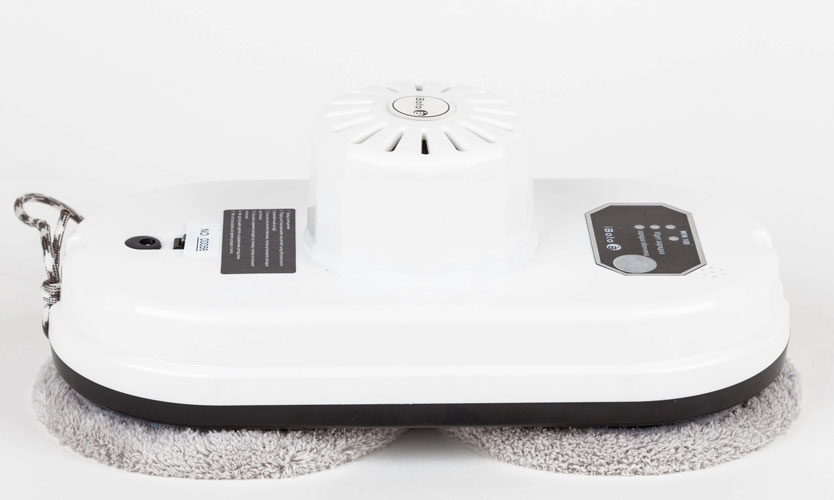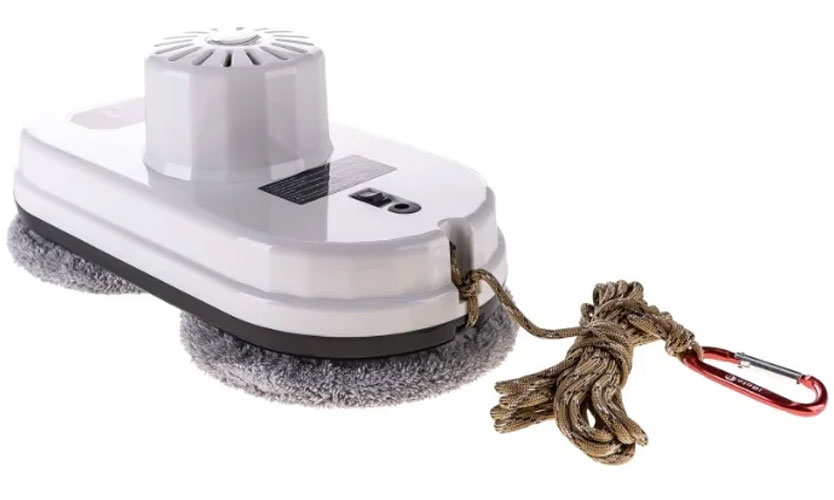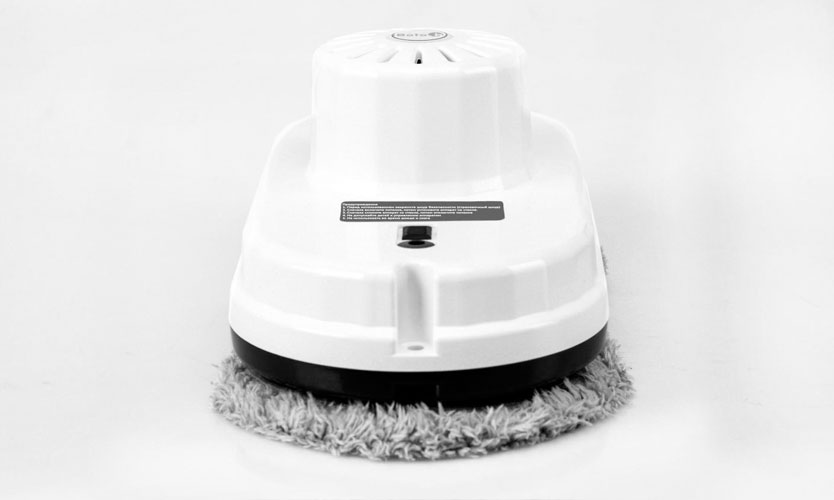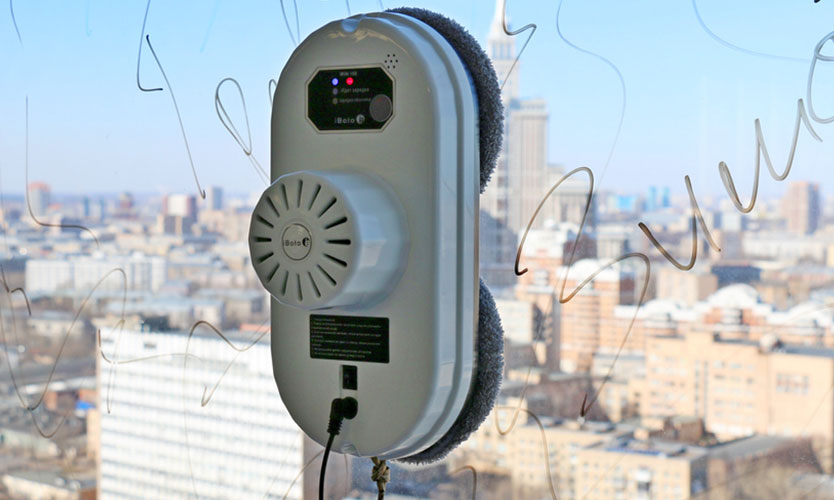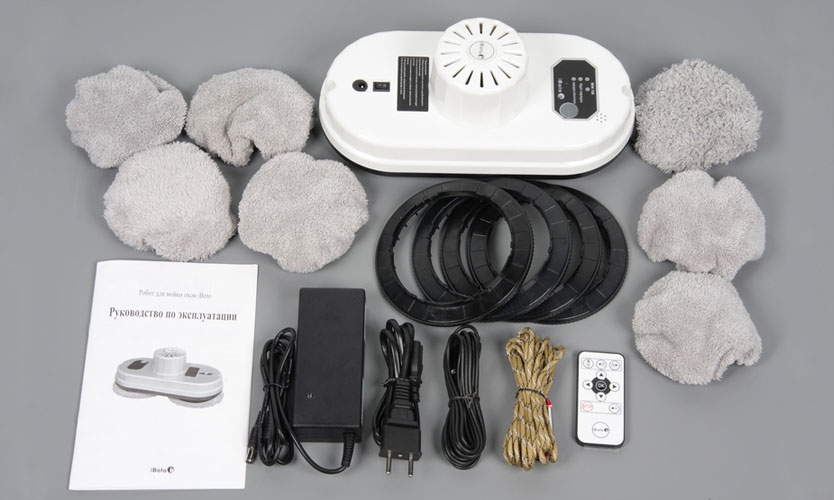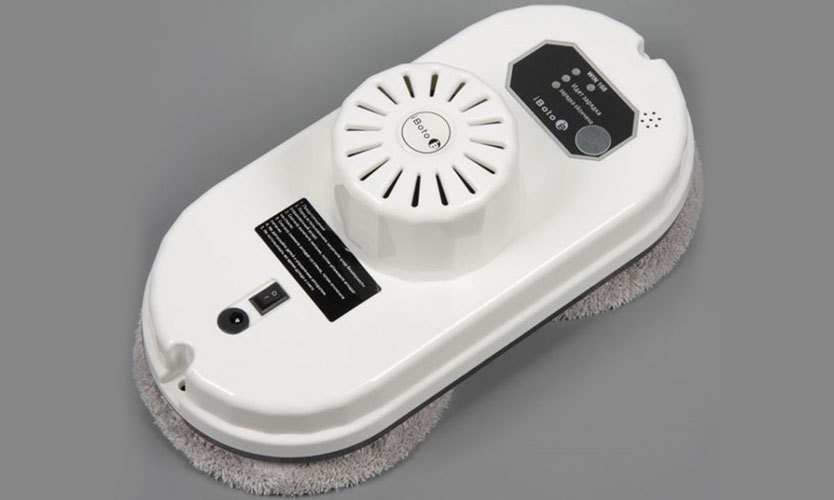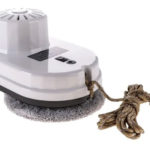Not an ordinary and not yet quite familiar robot is a window cleaner. It independently moves along vertical surfaces, holding onto them with a vacuum, determines the boundaries of the windows, the entire area that needs to be cleaned can even be used to clean glass ceilings. This review will tell you more about the washer.
Specifications
- Movement by means of two driven wiping wheels and vacuum pressure.
- Carries out dry and wet wiping.
- Work in automatic and manual mode.
- Noise during operation no more than 69 dB.
- Remote control.
- Light and sound indication.
- Emergency holding time on glass 30 minutes.
- Charging takes about 240 minutes.
- Charging from the power supply.
- Weight 970 g.
- Dimensions - 143x120x290 mm.
- Average cost 17.
Design
The body is made of high strength plastic, its surface is smooth and semi-matt. The upper part of the case is painted white, the lower one is black. The material is not easily soiled, traces do not remain on it and minor mechanical damage is not visible, if a stain appears on the surface, it can be easily removed with an ordinary detergent. At the top, you can find a panel with an indication of the status of the robot, there is also an IR receiver window, a speaker that gives sound alerts, a mechanical power switch and connectors for connecting to a charger.
At the end there is a cylindrical protrusion, there is a hole in it for blowing air. On the side parts of the anchorage for the safety cord. At the bottom, an indication of operation and the presence of an error is duplicated. A second IR receiver is installed at the bottom, which monitors the state of the robot, receives signals from the control system in the remote control, if the robot is on the reverse transparent side. On the top and bottom of the sticker with warning notices and short instructions.
The remote control is small, flat, the buttons are small, membrane. The cleaning wipes are round, made of synthetic terry microfiber with medium bristles on both sides. Rubber cords are sewn into the edges for attaching a napkin stretched on a plastic ring. These rings are mounted on wheels on the bottom.
Functional
Drive wheels - they are also a cleaning mechanism, are located on electric independent drives, one wheel can rotate independently of the rotation of the other. A powerful fan is installed in the casing, which constantly pumps air from the central part of the wheels. Provided that circles with napkins are fixed on them, the wheels work like suckers, holding the washer vertically on the surface.
When fully equipped, the weight of the robot does not reach a kilogram, the outer diameter of the wheels is slightly more than 14 cm. The wheels serve as a holding, cleaning and driving mechanism.The movement algorithm during cleaning is as follows: one wheel is strongly pressed against the surface and begins to rotate the apparatus relative to the axis of the fixing wheel, the free wheel accelerates its rotation, cleaning the glass. At the end of the cleaning of this area, the washer changes wheels, presses against the surface with others and repeats the step. Due to this movement, the robot moves on the glass and cleans it along the X and Y axes. The robot determines the frame border by resting the wheel on an obstacle when it is impossible to complete the rotation. Due to this feature, it cannot be used on frameless structures.
The battery charge is only used for holding in an emergency, but the gadget must always be connected directly to the network for it to work. The kit includes a cable to the power supply and from it to the connector on the washer, which in total is almost 700 cm. If this length is not enough to reach the power source, you will have to use an extension cord. When the power is turned off, the robot freezes and emits a warning sound indicating that it must be removed from the surface or reconnected to the power source.
After an emergency stop, it is necessary to fully replenish the battery charge, and only after that return the robot to work. The green indicator on the case indicates a recharged charge. It takes about 240 minutes to fully recharge. To protect the vacuum cleaner from falling, a safety cord is tied to it, one end of it is attached near the glass to be cleaned, the second on special mounts on the body. The cord also helps, if necessary, to pull the device towards you during an emergency stop in a hard-to-reach place.
Works in three automatic modes. In the first, the movement is carried out up to the uppermost border, then the snake goes down from the left to the right edge and vice versa. The second mode provides for movement to the left to the border, then downward with a snake. The third is moving to the right, then down. When cleaning is complete, the vacuum cleaner stops on its own. The program is selected according to the available area of the glass - at which point it is most convenient to stop the movement at the end of the cycle. There is also a manual control mode with the remote control. It is not allowed to use the robot in rain or in high humidity, if there are stickers or films on the glass, they can also interfere with movement.
On the recommendation of the manufacturer, two cleaning cycles should be carried out one after another: dry wipes sweep away the dust, after they are replaced with clean and wet ones, and the second cycle is carried out - wet cleaning. In the second cycle, the detergent is applied only to the wheel near the power connector, the second is left dry.
Not all cleaning products are suitable for use. Standard water-based products make the surface too slippery, wheels slip, and the robot may fall off the glass. If the product is too thick, it dries out too quickly, forming a film that blocks the movement of the wheels. Ideal based on isopropyl alcohol or distilled water. The napkin does not need to be completely moistened, just spray it from the spray bottle.
The noise level during operation is quite high - at a distance of a meter it is already audible at 69 dB. In the absence of movement, it starts to make noise louder - up to 73 dB, apparently this is due to the fact that the robot begins to stick more strongly to the surface.
The square robot cleans a glass of one meter in about 4.5 minutes using the upward travel program. The quality of cleaning cannot be called ideal, since the robot will not remove old dirt, it is especially difficult for him to cope with organic stains. Skips areas close to the frame. If you start the robot in a repeated cycle of work, it will eliminate all these shortcomings, but there will still be dirt in the corners, since the round wheels do not reach this area. It is effective for external cleaning of large windows, even if they cannot be accessed from below. For example, you can launch a robot through the window of a large window.
Equipment
- Power Supply.
- Network cable 1.5 m.
- Extension cord - 4 m.
- Safety cord and carabiner.
- IR remote control and battery to it.
- Nozzle rings.
- Napkins for reusable use.
Advantages and disadvantages
The robot shows such advantages in its functionality:
- Budget price.
- Easy to use.
- Can be used on a wide variety of surfaces.
- Emergency surface hold for 30 minutes.
- Nice appearance.
- Light weight and size.
- Gently cleans fragile materials.
- Reliability.
- Intelligent navigation.
- High speed of work.
- Safe to use.
Disadvantages:
- Noisy when working.
- Skips dirty areas in the corners.
- Sensitive to the choice of detergent.
See also: robotic vacuum cleaners before


